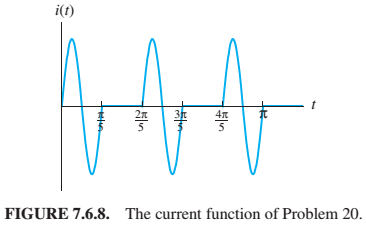
Repeat Problem 19, except suppose that the switch is alternately closed and opened at times
Now show that if
Thus the current in alternate cycles of length

Want to see the full answer?
Check out a sample textbook solution
Chapter 7 Solutions
Differential Equations: Computing and Modeling (5th Edition), Edwards, Penney & Calvis
Additional Engineering Textbook Solutions
Computer Science: An Overview (13th Edition) (What's New in Computer Science)
Objects First with Java: A Practical Introduction Using BlueJ (6th Edition)
Introduction to Java Programming and Data Structures, Comprehensive Version (11th Edition)
Java: An Introduction to Problem Solving and Programming (7th Edition)
Concepts Of Programming Languages
Web Development and Design Foundations with HTML5 (8th Edition)
- For P= 0 and compute the value of K under the condition. if (P <= 1) K = P + 5else if (P > 1 && P <= 5) K = P + 3else if (P > 8) K= P - 1else K = Parrow_forwardLet :P: Birds can fly.Q: 2+1=4.R: x is an integer.S: π is a rational number. ~ (p ⊕ ~ q) ν ~ (~r Λ s) GIVEN THE FOLLOWING PROPOSITIONS A. ILLUSTRATE THE COMBINATORIAL CIRCUIT.arrow_forwardQ_5 Suppose f:RZ where fx=2x-1.If A={x |1x 4}, find f(A).If B={3,4,5,6,7}, find f(B).If C={-9, -8}, find f^ - 1(C)arrow_forward
- with n=6 and A=(3,5,4,1,3,2). Draw the corresponding walkthrough as shownarrow_forwardIn each case below, show using the pumping lemma that the givenlanguage is not a CFL.e. L = {x ∈ {a, b, c}∗ | na(x) = max {nb(x), nc(x)}}arrow_forwardGiven A={1,2,3,4,5,6},B={4,5,6,7,8,9}. Compute (e)B⊕A= (f) (A−B)∩(B−A) =arrow_forward
- Simplify the following Boolean function , using three- variable maps: a) F(x,y,z) = Σ (0,2,6,7) b) F(A,B,C ) = Σ (0,2,3,4,6) c) F(a,b,c) = Σ (0,1,2,3,7) d) F(x,y,z) = Σ (3,5,6,7)arrow_forwardFibonacci numbers F1, F2, F3, . . . are defined by the rule: F1 = F2 = 1 and Fk = Fk−2 + Fk−1 for k > 2. Lucas numbers L1, L2, L3, . . . are defined in a similar way by the rule: L1 = 1, L2 = 3 and Lk = Lk−2 + Lk−1 for k > 2. Show that Fibonacci and Lucas numbers satisfy the following equality for all n ≥ 2 Ln = Fn−1 + Fn+1.arrow_forwardAES uses operations performed over the finite field GF(2^8) with the irreducible polynomialx8 + x4 + x3 + x + 1. Q: In a finite field GF(2^8) with the irreducible polynomial x^8 + x^4 + x^3 + x + 1, given two bytes of inputs, explain how the addition works.arrow_forward
 Database System ConceptsComputer ScienceISBN:9780078022159Author:Abraham Silberschatz Professor, Henry F. Korth, S. SudarshanPublisher:McGraw-Hill Education
Database System ConceptsComputer ScienceISBN:9780078022159Author:Abraham Silberschatz Professor, Henry F. Korth, S. SudarshanPublisher:McGraw-Hill Education Starting Out with Python (4th Edition)Computer ScienceISBN:9780134444321Author:Tony GaddisPublisher:PEARSON
Starting Out with Python (4th Edition)Computer ScienceISBN:9780134444321Author:Tony GaddisPublisher:PEARSON Digital Fundamentals (11th Edition)Computer ScienceISBN:9780132737968Author:Thomas L. FloydPublisher:PEARSON
Digital Fundamentals (11th Edition)Computer ScienceISBN:9780132737968Author:Thomas L. FloydPublisher:PEARSON C How to Program (8th Edition)Computer ScienceISBN:9780133976892Author:Paul J. Deitel, Harvey DeitelPublisher:PEARSON
C How to Program (8th Edition)Computer ScienceISBN:9780133976892Author:Paul J. Deitel, Harvey DeitelPublisher:PEARSON Database Systems: Design, Implementation, & Manag...Computer ScienceISBN:9781337627900Author:Carlos Coronel, Steven MorrisPublisher:Cengage Learning
Database Systems: Design, Implementation, & Manag...Computer ScienceISBN:9781337627900Author:Carlos Coronel, Steven MorrisPublisher:Cengage Learning Programmable Logic ControllersComputer ScienceISBN:9780073373843Author:Frank D. PetruzellaPublisher:McGraw-Hill Education
Programmable Logic ControllersComputer ScienceISBN:9780073373843Author:Frank D. PetruzellaPublisher:McGraw-Hill Education





